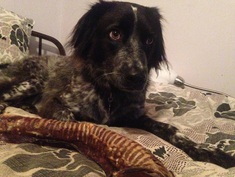 Dogs communicate in a number of ways. Body language is their number one way of “talking,” but vocalizations are also important. They bark, they howl, they whine… and they growl. It’s the last one that gets us, as humans, the most riled up. When I do evaluations for dogs who have shown aggressive behavior, one of the most common questions I get is, “What do I do when they growl?” This is a loaded question. Here’s the thing: growling is communication. It is your dog’s simplest and least dangerous way to let you know that they are not okay with something. So while many people feel like they should punish growling because they see it as aggressive behavior, the absolute last thing you want to do is punish a growling dog. It’s natural for us to be upset when our dog growls. For many people, the growl in itself is an aggressive behavior. I see it as a warning, and an appropriate social skill. Your dog is letting you know that they are not okay – maybe they are scared, maybe they feel threatened, maybe they are in pain, or just frustrated or annoyed. But something is not right, and they are approaching a point where they could go over threshold and bite. I love this quote from trainer Yamei Ross - "Punishing a dog for growling is like taking the batteries out of your smoke detector. You don't want to hear the noise, but the danger is still there." Essentially, if you get rid of growling by punishing your dog for it, you are teaching them to skip their safe, socially acceptable (in the doggie world) warning and go straight to the next step – for many dogs, this could be a bite. What we really want to do is address the REASON your dog is growling. Long term, that is going to give you the most success in having a good relationship with your dog and preventing the growling from happening. But what do you do in the moment, when your dog is growling? First, stop and assess the situation. Stay calm and go slowly. Does your dog have a resource like a bone or food they may be protecting? Is something making them fearful or uncomfortable? If I am approaching the dog, at this point I would make sure to not move any closer until I have a better idea of what is happening. Second, and probably the most important piece of this puzzle, DO NOT ESCALATE THE SITUATION. (I had to yell that bit because it is so important and this is where most people go wrong in bite situations.) It is not necessary to “tell your dog who’s boss” or “not let them win” in this scenario. There is NO winning when a dog bites – you lose, they lose, everyone loses. Third, figure out a way to safely proceed or retreat. If your dog is scared and you can safely remove them from the space, go ahead and do so. Find a quiet area like a crate or empty room for them to calm down. Remember that scary situations release stress hormones in your dog’s body and they may not immediately be okay when the stressful thing is removed, even if they seem more relaxed. If your dog is guarding something like a bone, see if you can call them away from the object or trade them for something better. Again, only try this if you feel like you safely can without escalating the situation. This may mean you “lose” this time, but it keeps everyone safe and gives you information you can use. Fourth, make a training plan. This would be a good time to call a professional trainer or behavior consultant if you are not already working with one. Someone who has experience with these issues can help you identify the root of the problem and how to make your dog better moving forward. This will probably involve a combination of management to prevent the issue and training to teach them better responses or to change a negative association to a positive one. If you are ever uncertain about what to do in the moment, just remember: never escalate the situation, and don’t be afraid to get help. Growling is communication, and it should always be listened to and taken seriously. Ignoring a growl could lead to a bite, and that is never good news for the dog or person involved.
7 Comments
|
Sarah Bond
Sarah is a Certified Dog Behavior Consultant and Certified Professional Dog Trainer - Knowledge and Skills Assessed. She lives in the Texas Hill Country near Austin with her two dogs, Percy, a cattle dog mix, and Clara, a lab/German Shepherd. Archives
October 2020
Categories |
 RSS Feed
RSS Feed